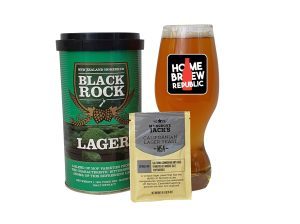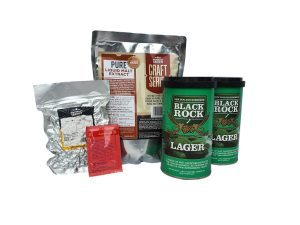
HBR Recipe#3 Classic Lager
A traditional style lager with a light hop forward profile creating an element of old school sophistication and and depth to the flavour in an otherwise crisp and light bodied lager.
I want to start with a story. If it’s too early for a cold brew I like hot brews. Specifically, I like coffee and I only like ‘real’ coffee. My coffee of choice is a long black, and its notoriously hard to find a place that makes a good one. And unlike any batch of beer, I have ever brewed (although I acknowledge I have come close once or twice) I have been served coffee multiple times that I refused to drink.
Given my commitment to a good brew its not uncommon for me to get to know the local shops and the staff that make the good brews. One day my coffee guy, Hunter, shared some comments while he was making my coffee. He explained that a Long or Short Black are the hardest coffees to make, because there’s nowhere to go if you make a mistake.
And there’s plenty of places you can make a mistake. You might have beans that have been poorly roasted or a low quality to start with. The grinder could be running hot and burn the grind. If you place the incorrect amount of coffee in the handle or the coffee doesn’t extract at the required pressure – you can get a bad coffee.
Whereas with any milk-based coffee like a Latte or Flat White, continued Hunter, you have something you can use to cover up minor imperfections – and still make a good coffee.
In many ways this is not dis-similar to brewing – even with kit brewing – if you have imperfections in your process or you are using low quality ingredients these will likely impact the your final product – and like a long or short black there is nowhere to hide.
My point. Albeit I appreciate this comment isn’t broadly correct, within the context of the story hops to brewers can be as milk is to baristas. Hops can be the magic ingredient that you can use to personalise your brews and cover minor mistakes in a brewing process to help produce good beer.
Tip #1 Keep Calm. And Maintain Cleanliness.
Tip #2 Keep Your Cool.
Hops are the flower of a hop plants (Humulus Lupulus) and in the context of beer are primarily used as a bittering or flavouring ingredient to balance the sweetness of the malt. Most commonly hops will create a fruity, citrus or floral flavour and aroma but there are many varieties offering earthy, herbal or even spicy tones.
Although you can source fresh hops, home brewers more commonly use dry hop pallets, which is the processed form of the fresh hop.
It’s very likely the malt extract from the base kit we use in our wort will have already been hopped to create the specific flavour profile of kit.
The easiest way to incorporate hops into your brewing process is by dry hopping.
Dry hopping is the process of adding hops to a brew in the fermentation vessel to create or enhance specific flavours, aromas or ‘hoppy’ characteristics, without extracting more of the bittering qualities of hops.
I have always maintained that kit brewing leaves brewers plenty of room to experiment – and dry-hopping is certainly one of the easy opportunities brewers can use to create their own unique brews.
Adding hops to a brew or changing the hop you use can completely change the finished product.
There are a few ways to approach dry hopping.
The first consideration is when you add hops to a brew. The three basic options would be right from the start of fermentation when you set the brew up, at some point during fermentation, for example on day four or day seven, or at the very end of fermentation, for example forty-eight hours before you prepare to bottle your brew.
The earlier you add the hops the more transfer of characters like aroma and flavour you will get into the brew and the later you add the hops the less transfer you will get. Rather than elapsed duration some kits will use a specific gravity level like 1.025 to determine the stage of fermentation at which hops are added.
The second variable would be the volume of hops that are used. For me I tend to generally use either 50 grams or 30 grams. However, there are times I have used up to or over 100g grams of hops. The greater the volume of hops you use, the greater the intensity of flavours and aromas you will add to the brew.
The third variable would be how you add the hops to the brew. I tend towards going ‘commando’ – simply disbursing the hops lose into the fermentation vessel. The theory supporting this approach is that you increase the surface contact area between the hop pallets and the brew, which will optimise the transfer of characteristics. The drawback to this approach would be organic particles floating around in my fermenter. But I counter this by using finings, cold crashing and using a sediment filter.
The alternative approach would be to use a hop sock or a hop cage. This will contain the hops and allow you to largely remove the ‘mush’ before you prepare your brew for bottling.
To keep it simple think about what flavour you want, how strong you want it and how it will complement the base kit or other ingredients you are using.
The two things I tend to look for, without overcomplicating or overthinking the process are the key tones in the base kit and the strength of the tones. Also look at your yeast, if you are using a premium yeast, which may create or support a particular flavour profile or character.
If you had a kit that had fruity tones, a yeast that had a subtle citrus flavour profile and then used a floral hop it might just turn into a weird mashup.
For example, the flavour profile of the Mangrove Jack’s Traditional Series Lucky Goat Pale Ale is described as having soft fruit undertones. The two key words being ‘soft’ and ‘fruit’.
In this case I would look for a hop with a fruity profile to compliment the kit and use a smaller volume of hops, potentially 30 grams as to not overpower the flavour profile of the kit or create a heavy hop forward character. Two good hops to consider in this example would be the NZ Rakau (tropical) or Moutere (tropical, grapefruit and passionfruit).
And if I was considering a complimentary yeast to go with this brew I would probably look at the SafAle S-33 which is ideal to enhance hoppy and fruity expressions.
Not all manufacturers publish the specific hops or the flavour profile of hops that are used. In these cases, there is nothing wrong with outright experimenting – or brewing the kit once by itself without hops or a premium yeast to get an idea of the flavour profile.
Think about what you want in the beer. Even within a broad profile like ‘fruity’ there is a myriad of options offered by hops. You could introduce a tropical fruit character, a stone fruit character or dried fruit character – to give you a few examples. Or within a citrus profile you can find lime, grapefruit, or citrus fruit. There are out-there hops like the Nelson Sauvin which will give you Gooseberry flavour or a classic American Hop like the Columbus which will offer herbal and earthy tones.
And don’t feel constrained to simply using one hop variety. It’s quite common for recipes to combine two or three hop varieties in dry hopping.
We have given some lose guidelines already in this article. But the key thing to think about is balance.
I would think about the strength of flavours in the base kit – even if only from the malt characteristics, and the body.
If the goal is balance, a light bodied beer, with a subtle flavour profile might not be enjoyable with a heavy hop characteristic and intense hop-forward flavours that overpower the brew. Conversely a brew that had a stronger malt characteristic, like an APA or a stout and potentially some more body would probably require a greater volume of hops for the hop characteristics to have an enjoyable presence in the brew.
How much hop characteristic you like with any given brew can be a personal preference you develop over time. If you are looking for a starting postion 30-50 grams with lagers, pilsners or pale ales is a safe place to start and up to 70 grams with meltier brews like an APA or a stout.
If everything we’ve written above sounds like too much to think about an easy way to step into dry hopping and premium yeasts is using craft series brewing kits like the Mangrove Jack’s Juicy Session IPA or one of our Home Brew Republic recipes.
Craft Series brewing kits come with hops and premium yeast included. And Home Brew Republic Recipes have been tested and reviewed. Both options offer you a predictable way to begin using hops while you get a feel for how to use hops in your brews.

A traditional style lager with a light hop forward profile creating an element of old school sophistication and and depth to the flavour in an otherwise crisp and light bodied lager.

There no doubt that this brew must have been inspired by island life.
Pineapple and Passionfruit lead the charge in the aroma and flavour profile with a strong 5.5-6.5% ABV and and a subtle bitterness.

Using the Mangrove Jack’s NZ Brewers Series APA kit, the aptly named NZ APA recipe is a light bodied brew with a crisp and refreshing finish.
Our goal is to help you make good brews that you enjoy drinking, and if you want to share that your friends and family will be happy to drink with you.
Would you take one minute to give us some comments on this article? Your feedback helps us improve our content.
And if there’s anything we missed we’re always happy to drop you an email.
Cheers, Russell
Your cart is empty Continue Shopping